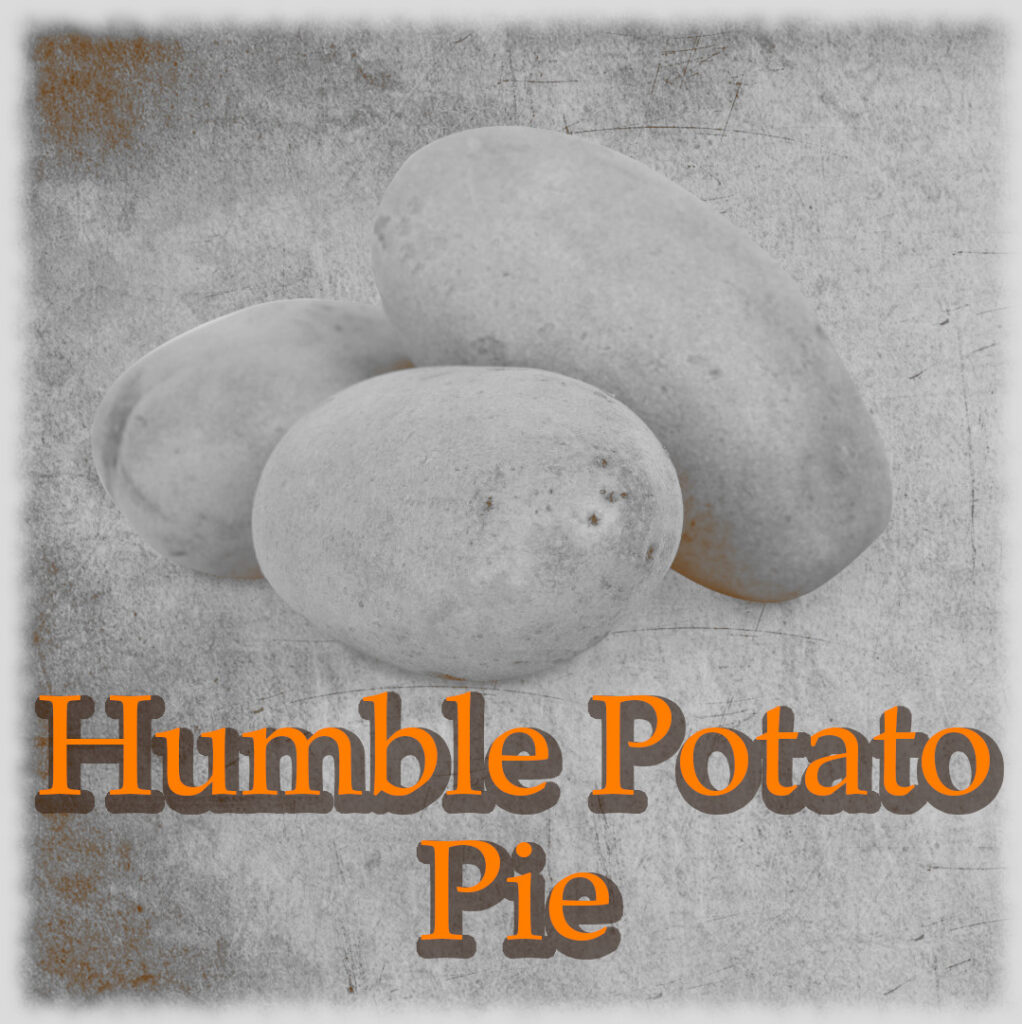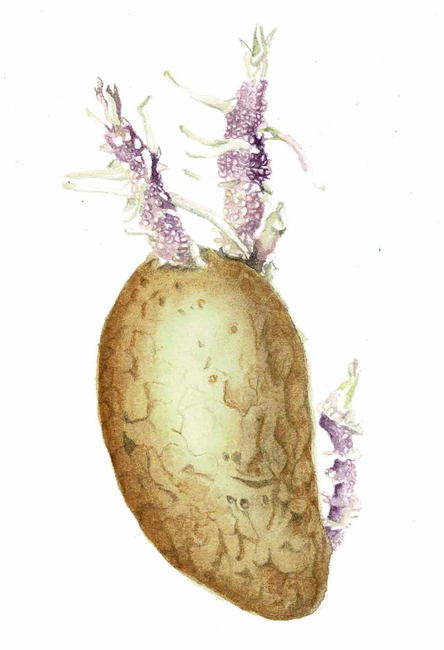
A special thanks to Fiona Mallin for allowing me use this birthday inspired blog and to Audry O’Reilly for the anotomically correct illustration of a potato.
For me, the dinner table has always been as much about boisterous conversation as it has been about food. Reeled in from the four corners of the house as teenagers, my siblings and I were expected to be excited by ideas and to contribute to dinner table discussions. These could be on the issues of the day; the need to understand history and why it was important; novelists and their contribution to literature; crime novels with their twists and turns; the lives of poets when compared to their poetry. There was also much animated discussion of drama and dramatists, one of my father’s favourite topics. The only thing we did not discuss at the table was food itself. But somewhere on my journey through life food became important to me. If certain anecdotes are to be believed, this happened early. It seems, that by four, I objected to the taste of gravy made from the same water which had boiled the carrots.
There were cookbooks everywhere about our living room. These migrated from one table to another as my mother looked things up, wrote down recipes for friends or, simply, savoured the idea of eating some extravagant dish or other. All these books were filled with slips of newspaper cut-outs. These contained new recipes, the latest in culinary ideas, and trendy, party foods. It came as no surprise, therefore, when my sister told me that she was putting together a cookbook to celebrate a friend’s birthday. She was collecting personal memories from family members and acquaintances and hoped to interleave them with recipes for her friend. This was to be a very personal cookbook and she wanted me to contribute. After a little brainstorming all my ideas were dismissed, so I decided to dedicate this blog about the humble potato to Fiona, who I hope enjoys reading it as much as I enjoy writing it.
It may seem like an opt out, an Irish cliché to talk about the potato. To even mention something so mundane to a reader of Sunday supplements could almost be classified as a criminal offence these days. To write a complete article about our starchy friend for an accomplished cook, might even be classified by some as a capital offence. But it is not a crime to talk food to a cook. We love to share more than a meal and a bottle of wine. Just as physicists get excited by muons we salivate at the thoughts of everything gastronomic from layered flavours to raw ingredients.
You may think that the potato offers nothing to talk about and that once I have discussed Boxty, Chomp, or Colcannon have exhausted all the spud has to offer. However, that is to underestimate this versatile tuber. And as for the potato being only an only Irish staple, think again. Ever since Christopher Columbus returned from “India” with this new vegetable, Europeans have slavishly worked on branding the potato with their unique, national mark. The Russian Banana sounds interesting, until you realise that it is not a tropical fruit but an oddly shaped spud. The King Edward is not only a cigar, but also a potato, determined to identify with its country of origin. The Duke of York is another piece of chauvinism, as is the French Fingerling. And when it comes to the Irish potato, we had a gem of a spud in the 18th century which the patriots of the time let down when it came to naming. Instead of the St. Patrick or, perhaps, the Finn Mac Camhaill (Mc Cool,) our legendary hero, the potato became known as the Irish Lumpy. It seems that the marketing men of the time had never heard the adage, when marketing a sausage, you sell the sizzle, not the porky bits.

This versatile tuber comes in many forms, waxy or starchy, boiled or baked, roasted, or mashed; for every need there is a spud. Whether your tastes run to Duchesse Potatoes, or you simply like your potatoes boiled and steamed, a knob of butter melting down its sides, with a parsley garnish to top it off; I bet that your thoughts never stray from the savoury to the sweet. I am not talking about the sweet potato, technically a yam, I mean using the potato as the main ingredient in a dessert.
I have seen chefs pour rhubarb into a potato well. But they were not intentionally creating a dessert. They were using the rhubarb as an extra taste in a savoury dish, in the way an apple sauce is used with pork. I am talking about replacing the pavlova with potato. I agree, it sounds improbable, but that is what one Victorian, Irish housewife apparently did. Sadly, the recipe for this dessert still exists as it was recorded in the kitchen cookbook and passed down the generations. It shows the importance of not recording our mistakes. Check out some YouTube cooking videos if you doubt me on this. Anybody following some of these would-be tv-chefs are doomed to a bad case of indigestion at the very least.
The inventor of this dessert lived in a time when ice cream was a seasonal treat and when strawberries had a two-week window in June. But it was also a time of scientific investigation. A revolution was underway, which could be why this innovative woman strayed from the tried and tested Bread and Butter Pudding, dismissed the Spotted Dick, and had an aversion to milk puddings.
We will never know what drove her down the road to potential infamy. Maybe, she had enough French to have heard the phrase pomme de terre and, being inquisitive, she wondered how stewed apple would compare with the apple of the earth.
Whatever drove her, she would soon have realised the mammoth task ahead. And she did not have the industrial might which could eventually have led to a successful conclusion. (It takes huge resources, afterall, to milk a nut.) While she may have asked herself, if an omelette can be both sweet or savoury, why then not the potato? She evidently did not wait for an answer to reveal itself, because the answers are both obvious and plentiful.
The first objection would have been that of texture, which for a spud is undisguisable. No amount of sugar and lemon can hide the origin of such a dessert. And no matter how heroic the effort in the kitchen, the presentation of such a dessert presents problems. Should it be served hot, or cold? For instance. Hot, lemony, mashed potato does not sound good; cold sounds even worse. Also, imagine it in a bowl before you. What do you see? You see potato, with the jaundiced, unappetising appeal of cold turnip. Is there any way to give it eye-appeal?
Thankfully, nobody ever picked up on the idea of a spuddy dessert, the recipe remained hidden in a family archive for 150 years and the inventive housewife was never ridiculed for her starchy experiments. Today, Ireland’s most famous mashed potato dish is still Colcannon. We may argue over the name when it comes to kale, or scallions, but we do not argue about its taste. It is crunchy and savoury, all the things you expect from a potato dish. It is not a dessert, nor a gold mine -some parents hid pennies in Colcannon when I was a kid. Not that I ever needed bribing to rip into a plate of lemon-free unsweetened spuds. However, it would take a considerable bribe before I pondered a dessert trolly, at the end of a substantial meal, and reached out for a Lemon Potato Pudding.
